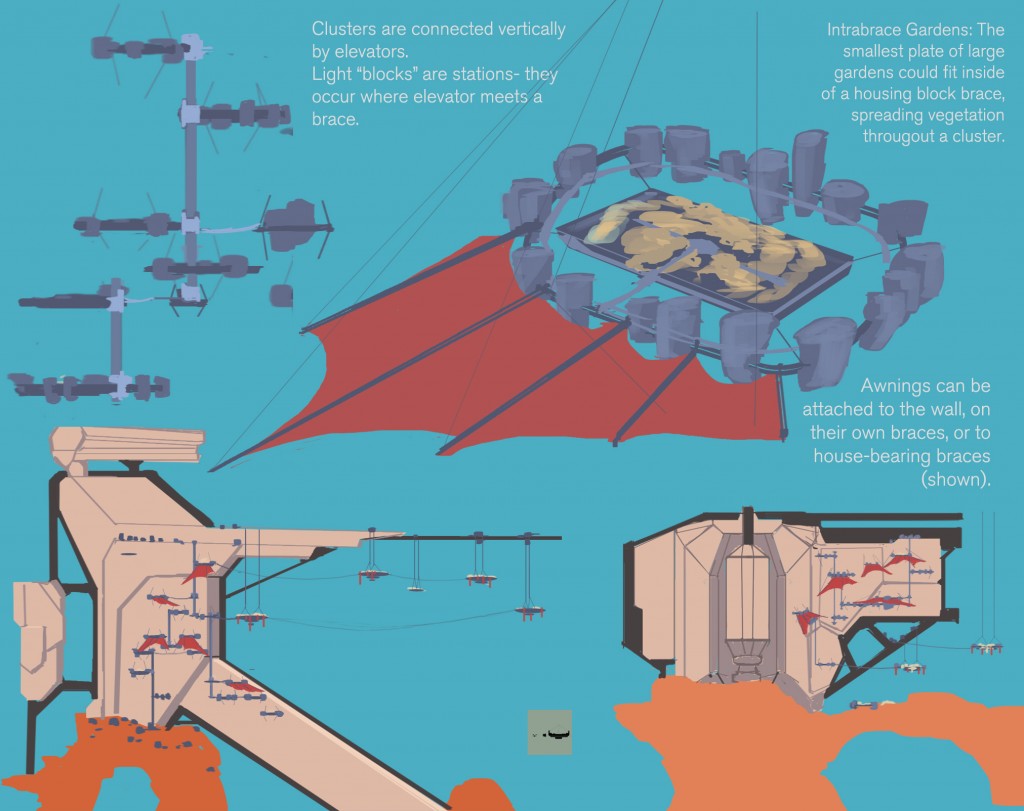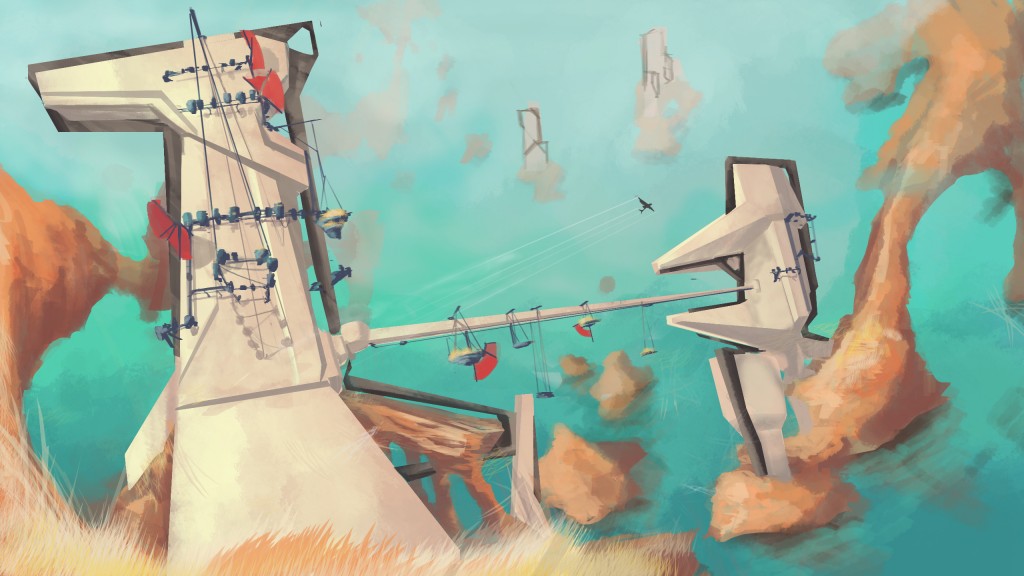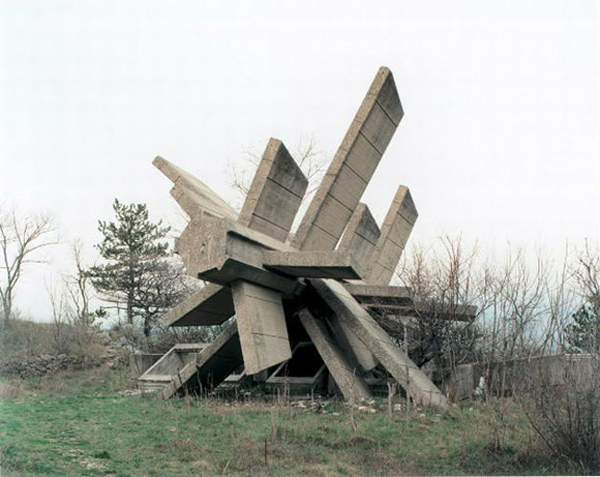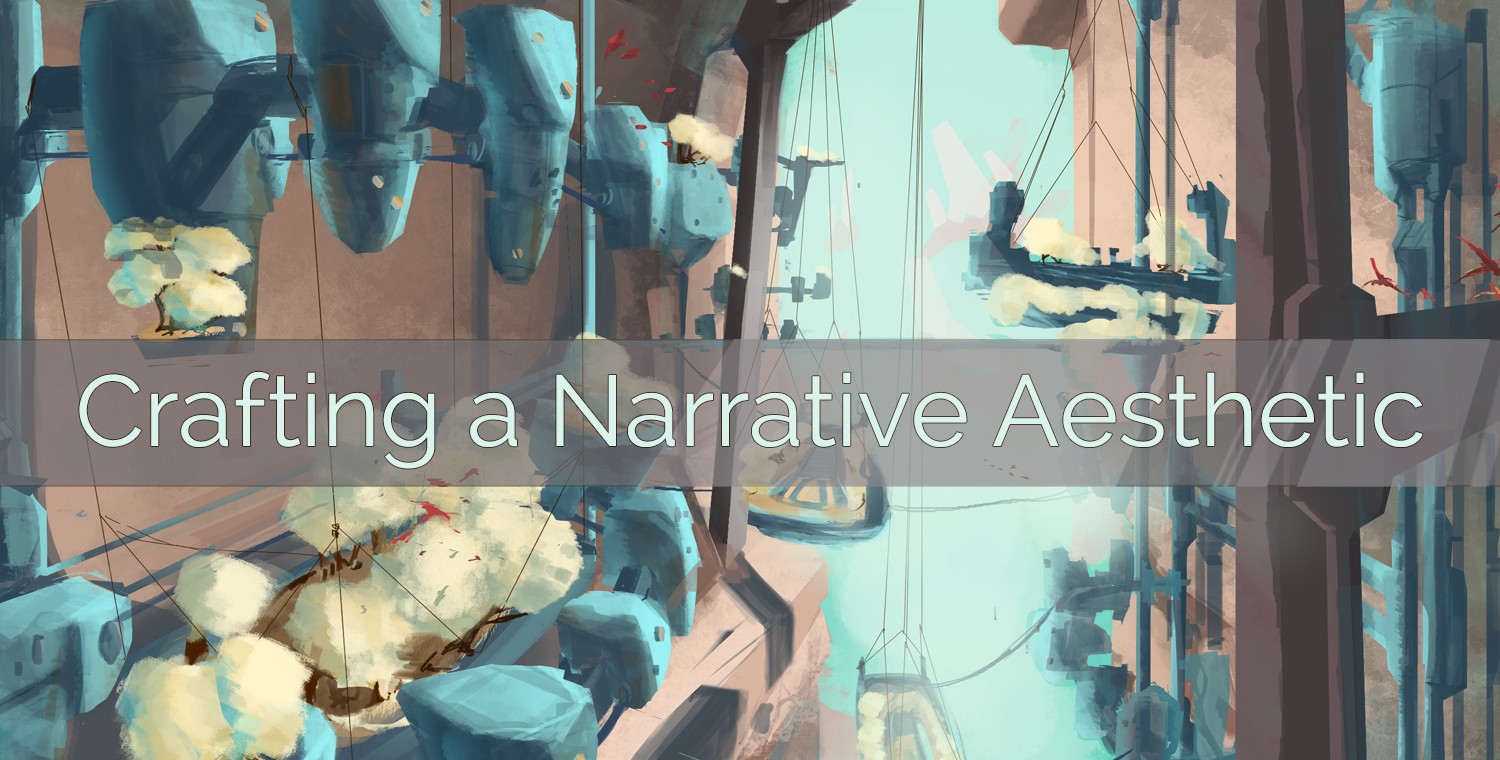“Narrative Aesthetic?”
InnerSpace is a game of exploration and discovery, where the object is neither fame nor fortune, but rather the unveiling of another world’s history and the cosmic forces that drive it. With priority given to honing our mechanics and gameplay to a fine point, we were left with an aesthetic challenge. What would make players want to spend their time in InnerSpace? How can we tell a story without breaking away from our gameplay? The solution: an art style that unifies gameplay and narrative, lending depth to the game’s universe while giving meaning to exploration.
Starting from…where?
Initially, we saw broad strokes: a colorful palette, a unique space, and a once-thriving world now silent. From these broad strokes, we had the kernel our setting. Our initial artistic choices pointed to the tone we wanted: to the depiction of an intriguing world that holds its secrets close. The question was, “Still, what kind of world would this be?” Who lived here, and how? What did they leave behind, and what does it look like?
These were questions of world-building, yes, but also of design. Though other entities populate our worlds (more on that later), the primary agents at work, from a design perspective, are the player and the environment. Movement through, and perception of, this space forms the core of the game’s experience. For this experience to amount to any kind of meaning or understanding, then, the environment, itself, must be more than a space for action. Building the world, conveying our narrative, and designing our game are each interlocking processes.

Some early structural and color explorations, drawn as we fleshed out our aesthetic.
Three-Piece Suit
In order to construct a gameplay environment that simultaneously conveys history and thematic subtext, three kinds of functions determine the design of objects in InnerSpace: mechanical, historical, and referential.
Mechanical Function
First and foremost, each object has a gameplay or mechanical function. Because these objects create the space for play, they have to give the player opportunities to use his or her skills and the tools at hand. If it’s no fun to fly through, or if the environment poses no challenge to overcome, then there’s no incentive for the player to push further and dig, figuratively, deeper.
Historical Function
Most important for world-building is an object’s historical, or in-world, function. Rather than adhere to pure symbolism or arbitrary placement, objects are governed by the logic of the world itself, its weather systems, geology, or perhaps by the needs of now-absent civilizations. Considerations like this help us keep the game world internally consistent, giving us systems within which varied designs arise.

A preliminary sketch showing ways that structures from different epochs might interact, based on the materials and methods available to the respective civilizations. This kind of work informs world-building as well as level design.
Referential Function
While the first two functions could generate a pretty interesting game world, the best fantasy is often grounded, in part, in reality. For our aesthetic, this means approaching design with a referential function in mind (this is a bit hazier and more conceptual than the first two functions). Basically, the idea is to draw inspiration for environment designs from disparate, but significant, sources. Though the first two functions largely determine the final form of a given object, this final consideration aims to inflect our environments with a familiar air. The game world can, in this way, be both grounded and foreign.
Stepping Out of Theory
This three-sided design philosophy affects every object in InnerSpace. It aims to imbue objects and the game world with meaning, which, in turn, can be found only through the interrogation of those physical spaces. Our towers, mute sentries clinging to rock formations, provide a good foundational example (fig 1).

Figure 1: Silent sentries. Their original purpose lost, they serve anew as the pillars of another now-dead civilization. Structures like this are designed with all 3 functions (mechanical, historical, and referential) in mind.
Towers like this punctuate the open world, acting as obstacles, but they also create pockets of space in which flight becomes more difficult.
Mechanically, they’re elemental, but necessary, physical barriers that create space.
Historically, towers like this bear witness to a long-since passed civilization. Their material, their form (interior and exterior), and their placement in relation to the terrain and to one another all carry the imprint of the civilization that built them. If the player comes to understand the logic behind these towers, he will come upon a mosaic that illustrates an otherwise silent history.
In terms of reference, towers like this are modeled on modern monuments (fig 2): marvels of concrete, optimistic for a time that never came. Like these monuments, the towers in our game are remnants from an earlier time and cannot divulge their purpose, directly. They bear an inherent mystery, and the oddity of their form, given without context, engenders curiosity on its own.

Figure 2. From “Spomeniks,” photographs by Jan Kempenears. Erected by Josip Broz Tito in the 1960s and 1970s to commemorate World War II, these monuments now seem like the remnants of a forgotten socialist future.
Wrap-Up
This is only a brief tour, kept that way so that the game can speak for itself in play, rather than text.
As a final note, we hope that when these functions work in tandem, the game’s environment becomes a space equal part physical and symbolic. In these worlds, life accretes layer by layer like coral. One civilization builds upon another, long passed, but suffers a similar fate. By the time the game begins, rust and ruin obscures and has transformed the logic beneath. With nobody around to speak to, this world asks the player to move, to see, and to think in new and dynamic ways, in order to tease out the solutions to its mysteries. We hope you’ll come and take a look around.



This is my favorite blog post so far! The visuals make me excited to see it all get fleshed out. I’m very interested to see all of the environments, worlds, and histories you guys come up with. Keep it up!
Thanks!
I absolutely love your website.. Great colors & theme.
Did you create this web site yourself? Please reply back as I’m planning
to create my very own website and would like to learn where you got this from or what the theme
is called. Appreciate it!
I use to be a web developer specializing the WordPress actually, but for this we simply used a theme. It looks nice and we’d rather put the time into our game!
You can check out he guys who made this theme here: http://themes.bavotasan.com/
Pretty great post. I simply stumbled upon your weblog and wanted to mention that I’ve truly enjoyed browsing your weblog posts. In any case I’ll be subscribing in your rss feed and I’m hoping you write once more very soon!
Thanks! We hope you keep finding stuff that you like here.
Hi, just wanted to mention, I enjoyed this blog post.
It was funny. Keep on posting!
Keep on working, great job!
Thanks!